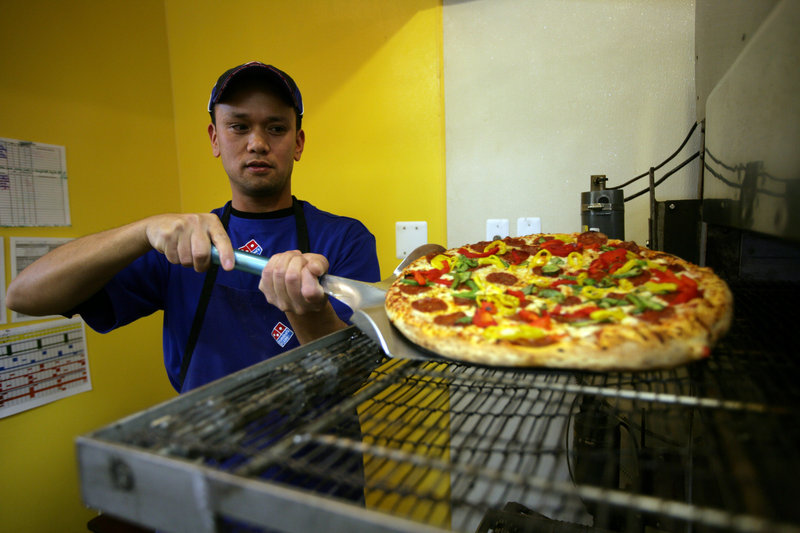DETROIT – To some, it may have been a cheesy ad.
The underlying theme of Domino’s recent national marketing campaign was that people disliked the company’s old pizza recipe. The advertisements announcing an improved pizza taste worked — and were the first volley in the latest round of pizza marketing battles.
In what some might view as a response — though they themselves do not — Little Caesars brought its Pizza! Pizza! campaign back.
Other major pizza players also unveiled new products and approaches this past year.
“This will remain a competitive category,” said Janney Capital Markets research analyst Mark Kalinowski. “Pizza’s probably held its own in terms of total market share as compared to the rest of the restaurant industry. … All in all, pizza’s not in a bad place at all.”
A tastier sauce, a better cheese combination, flavored crust, olive oil, a new crust thickness.
Those are some of the ingredients needed for an improved pizza recipe — and for an epic pizza battle.
MARKETING CHEAP FAST FOOD
America’s largest pizzeria chains are duking it out across counters and doorsteps, as ever-budget-conscious people, still recovering from the recession, continue to look for cheap fast food.
But most notably, in this pizza war, the doughboys are fighting not only across the country, but across town, as two of the country’s biggest chains — Domino’s at No. 2 and Little Caesars at No. 4 — are Detroit-area companies.
Their weapons? Domino’s has a revamped pizza recipe, introduced December 2009 in a much-discussed ad campaign, that has translated into higher sales; for example, its 2010 third-quarter same-store sales were up 11.7 percent over the comparable period in 2009.
Little Caesar’s spear is the Nov. 1 introduction of Pizza! Pizza! Pantastic: Two Hot-n-Ready pizzas, one supreme and one pepperoni, for $9.99. The company is privately held and declined to share sales information but said it was reaching its goals.
‘VERY COMPETITIVE SECTOR’
“It’s going to remain a very competitive sector, in part, because you have multiple national players and you have a lot of strong regional players and on top of that, a lot of very good mom-and-pop operators,” said Kalinowski.
“In the aggregate, we have multiple industry sources saying smaller players are losing a lot of market share this year. That suggests their sales trends have not been nearly as good as Pizza Hut or Domino’s. It’s doing a lit bit better than the average restaurant sector, but again that’s through the strength of Pizza Hut, of Domino’s. This is not a case of a rising tide lifting all boats.”
Last year, Americans spent close to $36.3 billion on pizza, according to PMQ Pizza Magazine, an industry trade magazine. More than 8 percent of that went to Domino’s coffers and 3.11 percent to Little Caesars.
Of the 64,951 pizzerias open in this country as of March 2010, 42 percent are owned by the top 50 chains and control 48 percent of the sales.
Pizza Hut, based in Dallas and a subsidiary of Yum! Brands, ranks highest.
“It’s definitely the latest installment; they were already warring with one another over price,” said Jeremy White, editor of Pizza Today, another trade publication. “Domino’s obviously changed the game. They came out and said, ‘We’re making a massive overhaul to our core product. We don’t think it’s as good as it could be or should be, and the public doesn’t think so either.’ It earned them so much good will and credibility that’s now paying off. That was a risk and it’s paying off. You haven’t seen other companies doing as much.”
PART OF LARGER TREND
Nancy Childs, a professor of food marketing at St. Joseph’s University in Philadelphia, sees the fight as part of a larger trend.
“They are intensive competitive marketers; they’re going to try to mimic each other and one up each other’s offerings, whether they’re competing on quality of ingredients and formulation and the latest deals,” she said. “To the degree they’re going to go national, they’re going to be competitive. You see that with Pepsi and Coke. You see that with the car manufacturers.”
Both Little Caesars and Domino’s declined to say how much they spent on advertising.
Brandon Solano, Domino’s vice president of innovation, called the bad economy a headwind in Domino’s gains, but also stressed that his company’s marketing campaign about its updated flavor profile impressed customers with its honesty. After all, thousands of products are improved every year, but without fanfare.
“The pizza industry has seen a lot of competitors following one another. If they’re successful, you see them follow one another,” he said. “Coming out with a new recipe speaks to leadership not followship. … There were a lot of people who were looking for something better, and we gave it to them.”
According to Solano, Domino’s menus have changed 80 percent in the last year and a half, thanks to new products and tweaks, though the new recipe — the result of 45 different trials — marks the first major overhaul since the company launched 50 years ago.
Send questions/comments to the editors.



Success. Please wait for the page to reload. If the page does not reload within 5 seconds, please refresh the page.
Enter your email and password to access comments.
Hi, to comment on stories you must . This profile is in addition to your subscription and website login.
Already have a commenting profile? .
Invalid username/password.
Please check your email to confirm and complete your registration.
Only subscribers are eligible to post comments. Please subscribe or login first for digital access. Here’s why.
Use the form below to reset your password. When you've submitted your account email, we will send an email with a reset code.